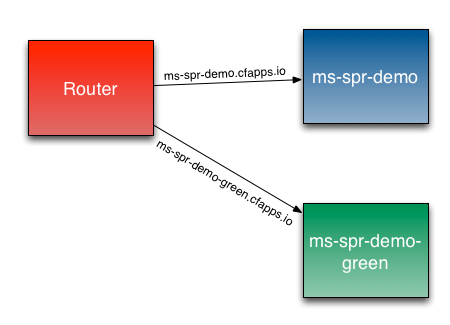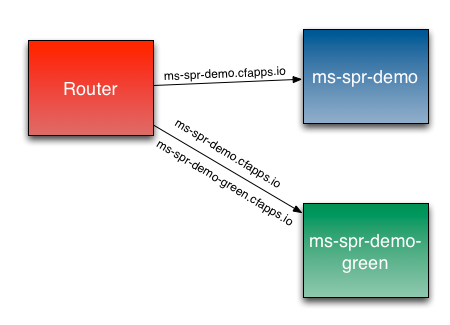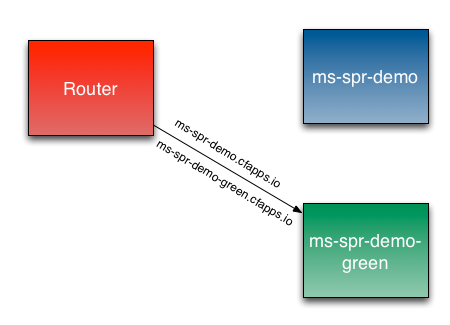丁轶群 | 2014-12-02
前言
原文地址:Blue-Green Deployments on Cloud Foundry
We’ll begin with a basic Spring application named ms-spr-demo. This app takes users to a simple web page announcing the ubiquitous “Hello World!” message. We’ll utilize the cf command-line interface to push the application:
这里先向CF PUSH一个很简单的打印“Hello World”的应用:
$ cf push --path build/libs/cf-demo.war
Name> ms-spr-demo
Instances> 1
Memory Limit> 512M
Creating ms-spr-demo... OK
1: ms-spr-demo
2: none
Subdomain> ms-spr-demo
1: cfapps.io
2: mattstine.com
3: none
Domain> 1
Creating route ms-spr-demo.cfapps.io... OK
Binding ms-spr-demo.cfapps.io to ms-spr-demo... OK
Create services for application?> n
Save configuration?> y
Saving to manifest.yml... OK
Uploading ms-spr-demo... OK
Starting ms-spr-demo... OK
-----> Downloaded app package (9.5M)
Installing java.
Downloading JDK...
Copying openjdk-1.7.0_25.tar.gz from the buildpack cache ...
Unpacking JDK to .jdk
Downloading Tomcat: apache-tomcat-7.0.41.tar.gz
Copying apache-tomcat-7.0.41.tar.gz from the buildpack cache ...
Unpacking Tomcat to .tomcat
Copying mysql-connector-java-5.1.12.jar from the buildpack cache ...
Copying postgresql-9.0-801.jdbc4.jar from the buildpack cache ...
Copying auto-reconfiguration-0.6.8.jar from the buildpack cache ...
-----> Uploading droplet (48M)
-----> Uploaded droplet
Checking ms-spr-demo...
Staging in progress...
Staging in progress...
Staging in progress...
Staging in progress...
Staging in progress...
Staging in progress...
Staging in progress...
0/1 instances: 1 starting
0/1 instances: 1 starting
0/1 instances: 1 starting
0/1 instances: 1 starting
0/1 instances: 1 starting
0/1 instances: 1 starting
0/1 instances: 1 starting
0/1 instances: 1 starting
0/1 instances: 1 starting
1/1 instances: 1 running
OK The end result of this cf push event is that an application is now serving requests at http://ms-spr-demo.cfapps.io. The following graphic shows the state of our system, with the CF Router sending traffic to our application:
这个应用的实例将被映射到 http://ms-spr-demo.cfapps.io 这个域名上,如下所示:

cf prompt us this time, we’ll make use of the manifest.yml file that we saved from our previous push. However, we’ll rename the application and provide a new route. Take a look:
接下来,我们对应用源码做了修改,使之打印“Goodbye World”,然后使用第一次部署时生成的manifest.yml来进行PUSH,不过,这一次我们将源码部署成一个新应用并映射了新域名:
--- applications: - name: ms-spr-demo-green memory: 512M instances: 1
url: ms-spr-demo-green.cfapps.io path: build/libs/cf-demo.war As you can see, we’re calling our new application version ms-spr-demo-green and we’re mapping it to the URL ms-spr-demo-green.cfapps.io. Let’s push the application:
下面开始PUSH:
Using manifest file manifest.yml
Creating ms-spr-demo-green... OK
1: ms-spr-demo-green
2: none
Subdomain> ms-spr-demo-green
1: cfapps.io
2: mattstine.com
3: none
Domain> 1
Creating route ms-spr-demo-green.cfapps.io... OK
Binding ms-spr-demo-green.cfapps.io to ms-spr-demo-green... OK
Uploading ms-spr-demo-green... OK
Starting ms-spr-demo-green... OK
-----> Downloaded app package (9.5M)
Installing java.
Downloading JDK...
Copying openjdk-1.7.0_25.tar.gz from the buildpack cache ...
Unpacking JDK to .jdk
Downloading Tomcat: apache-tomcat-7.0.41.tar.gz
Copying apache-tomcat-7.0.41.tar.gz from the buildpack cache ...
Unpacking Tomcat to .tomcat
Copying mysql-connector-java-5.1.12.jar from the buildpack cache ...
Copying postgresql-9.0-801.jdbc4.jar from the buildpack cache ...
Copying auto-reconfiguration-0.6.8.jar from the buildpack cache ...
-----> Uploading droplet (48M)
-----> Uploaded droplet
Checking ms-spr-demo-green...
Staging in progress...
Staging in progress...
Staging in progress...
0/1 instances: 1 starting
0/1 instances: 1 starting
0/1 instances: 1 starting
1/1 instances: 1 running
OK We now have two instances of the application running, each of them using distinct routes:
PUSH完成之后,两个应用都运行在CF上并且按照下述方式分配域名:

Now it’s time for the magic to happen. We’ll map our original URL route (ms-spr-demo.cfapps.io) to our “green” instance. This is accomplished very simply by using cf:
这时,我们将老应用(蓝色)的域名ms-spr-demo.cfapps.io同时映射到新应用(绿色)上:
cf map --app ms-spr-demo-green --host ms-spr-demo --domain cfapps.io Binding ms-spr-demo.cfapps.io to ms-spr-demo-green... OK The CF router immediately begins to load balance requests between each instance of the application, as shown here:
此时的域名映射如下图所示:

Now our router will send requests to ms-spr-demo.cfapps.io to both instances of the application, while ms-spr-demo-green.cfapps.io only services the “green” instance. Once we determine that all is well, it’s time to stop routing requests to the “blue” instance. This is just as simple using cf:
这样,ms-spr-demo.cfapps.io将流量导向了蓝绿两个应用,而ms-spr-demo-green.cfapps.io则只将流量导向新部署的绿色应用。这也是我们对绿色应用进行测试和观察的好时机(我们还可以调节蓝色和绿色应用的实例数目来进行流量分配比),一旦我们能够确定绿色应用能够正常的对外服务,接可以将蓝色应用实例切断了:
cf unmap --url ms-spr-demo.cfapps.io --app ms-spr-demo Unbinding ms-spr-demo.cfapps.io from ms-spr-demo... OK Our “blue” instance is now no longer receiving any web traffic:

We can now decomission our “blue” instance, or we can leave it around for a period of time in case we decide we need to roll back our changes. The important thing is that our customers suffered absolutely no downtime!
这样,ms-spr-demo.cfapps.io ms-spr-demo-green.cfapps.io都将流量导向了绿色应用,我们可以删除旧的蓝色应用或者保留一段时间以防意外情况。最后,我们可以把ms-spr-demo-green.cfapps.io这个测试域名也删除。 整个发布过程,用户没有感受到任何宕机或者服务重启。
附录 Martin Fowler大神提出的蓝绿发布:
One particular practice associated with Continuous Delivery is Blue-Green Deployments. Martin Fowler describes these very well at the link provided, but I’ll summarize briefly here:
- Cut-over to a new software version is tricky, and must be quick in order to minimize downtime events.
- Blue-green deployments ensure the parallel existence of two, identical (as possible) production environments.
- At any given point, only one (e.g. blue) services production traffic.
- New deploys are made to the other (e.g. green) environment. Final smoke testing is performed here.
- When green is determined ready, we begin routing traffic to it.
- We then stop routing traffic to blue.
